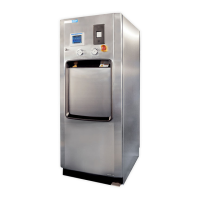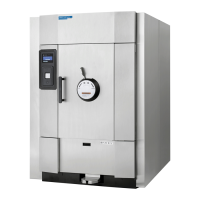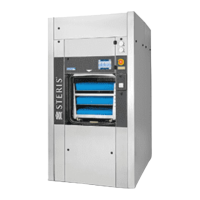6-17
Sterilizer Operation Operator Manual P129394-176
6.11 Liquid Cycle This cycle is used for sterilizing liquids in vented closures.
1. Refer to S
ECTION 6.1, BEFORE OPERATING THE STERILIZER, ON
PAGE 6-1 before running this cycle.
2. See instructions for using the loading car/transfer carriage or
rack and shelves, earlier in this section, for procedures to load
the sterilizer.
3. Press LIQUID touch-screen pad to start the Liquid cycle. Refer
to Table 6-3 for descriptions of cycle use.
NOTE: If the wrong cycle has been selected, see S
ECTION 6.15,
A
BORTING CYCLES, ON PAGE 6-30 in this section.
4. Sterilizer automatically progresses through cycle, as follows:
NOTE: The control display indicates cycle progress in two ways:
a. Large numerals in the screen’s center display estimated
remaining cycle time,
b. Change of phase name in the top status line of the screen.
ACTIVATE SEAL – Steam enters the door seal, pressing it
against inside surface of the door.
PURGE – Chamber is purged with steam. Start of condition is
printed.Countdown timer on the display is estimated; timer self-
corrects estimated time at the beginning of each phase.
CHARGE – Chamber is charged with steam. Start of steam
charge is printed.
STERILIZE – Start of sterilize exposure is printed when the
chamber reaches sterilization temperature. Chamber
temperature is printed every five minutes.
SLOW EXHAUST – Start of exhaust is printed and chamber is
exhausted to 0 psig.
SLOW EVACUATE – A vacuum is slowly drawn in the chamber to
5.0 inHg. This phase assures that the chamber is cooled to
208°F/95°C.
VAPOR REMOVAL – Filtered air enters the chamber at the same
time a vacuum is drawn to cool the load. Chamber pressure is
maintained between 1 and 5 inHg. Phase continues for
10 minutes.
AIR BREAK – Chamber is returned to atmospheric pressure.
RETRACT SEAL – A vacuum is drawn on the seal, retracting it
from inner surface of door.
COMPLETE – Complete tone sounds. Cycle summary and end of
cycle messages are printed.
5. Unload sterilizer (see instructions for using the loading car/
transfer carriage or rack and shelves, earlier in this section for
procedures to remove load).
WARNING – EXPLOSION
HAZARD: This sterilizer is not
designed to process flammable
compounds.
WARNING – PERSONAL INJURY
HAZARD: Avoid personal injury
from bursting bottles. Liquid
sterilization cycle must only be
used for liquids in borosilicate
(Pyrex) flasks with vented
closures.
WARNING: The liquid cycle is
for non-patient contact use
only.
WARNING – BURN HAZARD:
When sterilizing liquids, you
must observe the following
procedures:
• Use Liquid cycle only.
• Use only vented closures.
• Use only Type I borosilicate
glass bottles.
• Do not allow hot bottle to be
jolted.
• Steam may be released from
the chamber when door is
opened. Step back from the
sterilizer each time the door
is opened to minimize
contact with steam vapor.
CAUTION – POSSIBLE
EQUIPMENT DAMAGE
HAZARD: Sterilization of
chloride-containing solutions
(e.g., saline) can cause
chamber corrosion and is not
recommended by the
manufacturer. If, however,
chloride-containing solutions
must be processed, clean the
chamber after each use.
